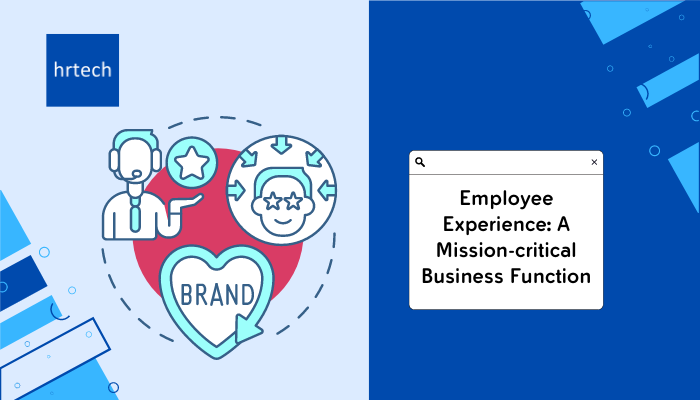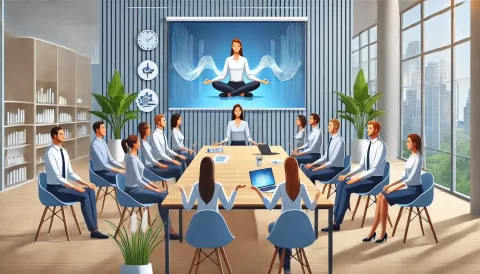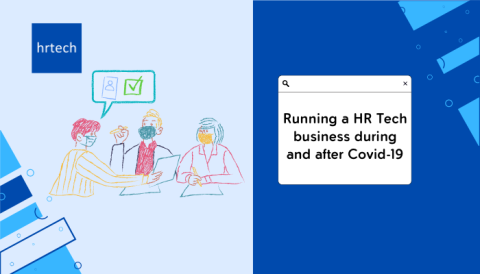Organizations are investing in various programs to improve life at work and focus exclusively on enhancing employee experiences. What today is a buzzword in the HR world was once secondary to businesses.
Positive psychology has been described in many ways. However, the commonly accepted definition can be put into these words – “Positive psychology is the scientific study of what makes life worth living.” The same can be narrowed down to work-life and employee experience.
Positive experiences at work make employees feel valued and deeply connected to their job. Employee experiences dictate how employees feel about themselves, the work they do and their relationship with the employer. With mental well-being becoming the priority for employees, strategic efforts to foster positive employee experiences should become the priority for organizations.
“The mission of the HR leader is evolving from that of “chief talent executive” to “chief employee experience officer.” |
The Rise of Employee Experience and its Origin
The evolution of HR and employee management over the last century has led us to the age of employee experience. Organizations in Singapore are investing in various programs to improve life at work and focus exclusively on enhancing employee experiences. What today is a buzzword in the HR world was once secondary to businesses. Organizations, traditionally, prioritized business profits over employee experiences. That is drastically changing now.
The evolution and importance of employee experience can be understood by defining the different era shifts in HR and employee management strategies over the last 100 years.
- The Utility Era: The evolution of employee experience and management started in the Utility era where employees were provided with the bare minimum facilities and tools to perform their job. In this era, employees were treated as a utility involved in a large chain of events. Organizations expected performance since the resources were provided, while people were happy having a source of income and work that provided some sense of purpose.
- The Productivity Era: The early 1900s marked the emergence of the productivity era where Frederick Winslow Taylor started a culture of rewarding employees who did their job better and surpassed expectations. The primary intention behind this strategy was to enhance employee performance and motivate them to do better. Organizations realised the need of providing incentives to increase employee productivity. This era emphasized strongly on productivity and creating repeatable processes.
- The Engagement Era: Organizations realised that the new generation came into the workplace with different expectations. The productivity and utility models might have worked for older generations but there was a need to revamp them. Over the last 30 years, more attention was given to employees, their thoughts about the work and workplace and their happiness. The idea of annual employee surveys emerged to create a feedback and engagement culture.
- The Employee Experience Era: Engagement is the result of the employee experience. The year 2021 marked the employee experience (EX) era. Organizations have realised that engagement is driven by the experience on offer, whether it’s for employees or customers. As per a Deloitte-Wall Street Journal article, the concept of EX originated as a parallel to the customer experience. Employees are the internal customers of an organization and it’s imperative to provide them with a consumer-grade experience.
In today’s business environment in Singapore, an excellent employee experience can give you the much-needed competitive edge and improve your employer brand to attract and retain top talent.
Employee Experience: A Critical Business Function
The global pandemic created a stress test for employees and employers. Business leaders deployed a series of actions in response to the crisis. These actions had a significant impact on employees and businesses with declining productivity, engagement and employee well-being.
This led to a great Employee Experience Awakening as more than 9 in 10 employers planned to prioritize employee experience for better business outcomes. Organizations are now realising the importance of a positive employee experience and making a conscious effort to focus on human experiences more than business processes. Employee experience is becoming a critical strategy as employers realise the direct correlation between EX and productivity.
HR leaders are no longer responsible for only recruiting and onboarding employees but also for ensuring a great experience throughout the employee lifecycle. EX is growing out from under the HR umbrella and emerging as its own mission-critical business function.
EX professionals offer a new level of support, flexibility and growth opportunity to employees and make them feel an integral part of the business. The evolution of employee experience has helped organizations to look beyond the traditional HR metrics like turnover and absentee rates, and think about enhancing productivity and employee well-being.
92% of employers worldwide said the employee experience will be a priority over the next three years. |
Employee Experience Team Structure, Roles and Designations
Generally, the EX team consists of the following roles and designations:
- Employee Experience Assistant
- =Employee Experience Consultant
- Employee Experience Manager
- Head of Employee Experience
In some organizations, the employee experience team structure is such that the EX professionals report to the Chief Human Resources Officer. In others, they are a part of the C-Suit leadership group where they actively strategize new employee experience and retention policies.
Responsibilities of the Employee Experience Team
The EX team specializes in designing employee experience frameworks and creating ways to measure employee engagement. From understanding the employee experience to assessing the impact of the work culture and policies on employee experience, they are the driving force behind enhancing employee experience.
EX teams strive to deliver a holistic solution to employee engagement and experience. They build and maintain a positive and fruitful work atmosphere. They essentially address matters beyond compensation packages, perks and employee benefits. They ensure every employee feels valued and an integral part of the company.
- Improving employee performance and productivity
- Creating a conducive work environment
- Focus on employee well-being
- Promote a diverse and inclusive culture
- Ensuring a smooth employee onboarding and training process
- Harnessing the power of technology to enhance employee experience
83% of HR leaders see Employee Experience as either important or very important to their organization’s success. |
Companies Adapting to New Workforce Dynamics by Creating a Top-notch Employee Experience
Companies in Singapore and across the world are improving employee experience as a whole, supported by a multitude of pulse feedback channels, wellness technology, employee self-service technology and tech-driven interactive employee experience platforms.
Business leaders and managers across disciplines are accountable for employee growth and development. The best way to enhance the employee experience is by offering opportunities for personal and professional growth.
The more employees see tangible investments the company makes in them, the better the experience. |
Strategies to Improve Employee Experience
Organizations across Singapore are using various strategies to improve the work-life balance and mental health of employees and deliver a top-notch employee experience
- Aligning Culture and Experience: The employee experience should be built to inherently reflect your company culture and value. Having a clear definition of your brand, purpose and culture will help you convey the same to your employees through every touchpoint.
- Customized Employee Surveys: You can’t improve what you don’t track. Employee surveys are the best tool to get insights into what your workforce thinks, feels and expects. Choosing customized surveys over-generalized ones will only show your employees that you care about their voice.
- Understanding Employee Journey: Designing employee experience for every defining touchpoint throughout the employee lifecycle is essential. Employee experience is not a one-off activity, rather a continuous journey. Much like customer experience, a single negative experience in the employee lifecycle can lead to problems.
- Making Every Moment Count : Employee experience dictates how engaged your workforce is. Organizations are designing all-encompassing employee experiences for all touchpoints during the employee lifecycle and ensuring that all employee interactions are authentic and reassuring.
- Encouraging Transparent Culture: Trust is often built on transparent communication. Organizations are offering open, two-way communication channels for the effective exchange of thoughts. Employees feel safe, comfortable and valued when their voice is heard.
- Leveraging Interactive Technology: Tech-driven employee experiences are an excellent way to keep employees engaged and motivated. User-friendly technology is an integral part of a positive employee experience and has the potential to streamline communication.
- Prioritising Work-life Balance: Employees who have a choice in when, where and how they work have higher levels of satisfaction and productivity. Organizations keep the work-life balance at the core while designing employee experiences.
- Feedback Management: It is very important for employees to believe their voice is heard. Immediate redressal of their feedback, suggestions or complaints will only further strengthen their trust in the company’s culture. A seamless and quick feedback management system is vital for employee experience.
- Employee Benchmark for Experience: Employees know best what they want from their employers. Utilizing multiple tools and platforms to interact with employees and understand their expectations will help you design just the experience they are looking for. Let employees set the benchmark and you surpass it.A McKinsey report states that the future of work will be increasingly remote. It’s a challenge and opportunity in itself to deliver a holistic experience to the remote workforce.
How Employee Experience Relates to the Physical vs Digital Workplace?
Employee experience is the journey of an employee that encapsulates every interaction with the organization and the values that add positive meaning to the role, workspace and mental well-being. This also includes the physical or digital workplace experience. The workplace design should reflect your company culture and make employees feel comfortable.
EX in Physical Workplace: Ergonomic features like high tables, comfortable chairs, natural light, plant walls, exercise options, can all contribute to enhancing the comfort level of employees. Every physical workplace should keep up with proper hygiene in the COVID-19 era. Proper ventilation, hand sanitiser dispensers, following and respecting hygiene rules (wearing masks, hand gloves, social distancing) will make employees feel safe at work.
EX in Digital Workplace: The workplace is no longer limited to office space. With remote work becoming a norm, the use of top-notch digital technology to improve employee experience is important. A digital workplace can make it easy and convenient for employees to stay connected with their work and colleagues in a remote working environment. Digital workplaces are secured and ensure data privacy. A seamless digital environment is a huge plus for employee experience. However, scratchy security architecture and inadequate tech support can result in a poor digital experience and cause major inconvenience to employees.
Importance of Company Culture and Values for Designing the Workplace Experience
According to a Willis Towers Watson survey, 37% of the organizations admitted that the pandemic has negatively shifted their organizational culture. 44% of employees experienced a positive impact of a transformative EX mapped to the organization culture.
According to a Forbes article, the company culture continues to be the most important factor in attracting and retaining talent:
- 52% of employees prioritized company value and culture while accepting a job in the Covid-19 pandemic.
- 81% of employees consider company culture while applying for a job.
- 35% of employees left the job in the first 90 days, citing company culture as the reason.
- Company culture is more important to college degree holders (51%) and employees living in cities (83%).
As there is a visible shift from employee engagement to employee experience, HR teams should not forget that the company culture and values - whether positive or negative - will have a huge impact on the workplace experience. |
Creating a strong company culture is not only the right thing to do but also a smart business strategy. There are a few common approaches that organizations in Singapore can take to build an employee experience around company culture and values.
- Clearly define Culture and Values: A clear definition of company culture and values can make it easier to take decisive steps towards creating employee experiences that resonate with the values. Company culture dictates the things that will be encouraged and promoted at the workplace. Your company culture will help you stand out since no two organizations will ever have the same culture.
- Have Employee Experience at the Heart of the Company Culture: Only a positive company culture will ensure that the employee journey is a positive end-to-end experience. Company culture should be designed by considering employees as the customers of the workplace. This creates a culture where employees are valued and offered the best of working environments.
- Actively Involve Employees: Employees know best what they want from the workplace. Actively involving their views, ideas and feedback will help you design the experience that is welcomed by the employees. Once you understand how employees perceive the company culture and what more things they would like to have, you can create a culture that is transparent and supportive.
- Strike a Balance: Organizations should be able to strike a balance between employee productivity and employee experience. It is easy to get carried away and create a culture focused on productivity while neglecting the EX. This approach will eventually backfire.
- Increased revenues and profits
- High employee satisfaction
- High motivation and morale
- Greater employee engagement
- Reduced attrition rates
- Improved employee experience
|
87% of HR executives admit company culture supports their business goals and 94% said it’s crucial for their organization’s success.
|
How is Employee Experience Linked to Attracting, Retaining and Developing Top Talent?
Organizations that offer exceptional EX, benefit largely from motivated employees who put in their best efforts. These benefits go well beyond just productivity and profits. Employees feel valued, confident and motivated. A motivated employee is always a better asset than a talented employee.
|
A survey, conducted by Workhuman, of more than 23,000 employees across 45 countries revealed that about 53% of employees are less likely to leave their jobs if they experience positivity and happiness in their workplace. Improving the employee experience is a proven way for retaining top talent. According to a LinkedIn survey, nearly 96% of HR leaders feel creating a positive employee experience will help them attract, retain and develop top talent.
According to a Survey by Willis Towers Watson, during the pandemic, employer actions had a significant impact on employees:
- 52% reported having moderate to high anxiety levels
- 66% had some work stress and distraction
- 52% believed they were hurt financially
- 35% experienced a drop in productivity
|
|
In the initial phase of the global pandemic, 72% of responding employees had full confidence in leaders to protect employee health and wellbeing, but by the end of the year, that number had fallen to 57%.
|
To attract and retain top talent, organizations in Singapore need to take effective measures to show they value their employees and care about their well-being. Creating an excellent work culture and employee experience will develop trust and mutual respect between the employees and employers. When employees feel they are in a safe environment where they can grow, they tend to work harder and surpass expectations.
Employee Experience across different Generations of the Workforce
According to a Gallup survey, Gen Z and millennials look for organizations that make conscious efforts towards promoting employee wellbeing. While the Gen X prioritized organization’s financial stability, the modern workforce wants an ethical leadership group in the organization that keeps diversity and inclusion practices at its core.
Older generations were raised with the philosophy that you are productive only if you are in the office. As generations changed, philosophy changed. There are various differentiating factors in terms of how employee experience is perceived by different generations on accounts of work-life balance, quality of work vs quantity of work and flexibility. The older generations preferred stay-in-office and face-to-face work culture, Gen X, Millennials and Gen Z tend to be more flexible in where and how they work.
To attract the modern workforce and develop the next generation of organizational leaders, every organization needs to focus on: ‘What does the young generation want from the workplace?’ |
The delivery mechanism of employee experience is as crucial as the experience itself. Gen X, millennials and Gen Z expect everything to be accessible at their fingertips while the older generations access information the traditional way. Mobile technology is a key factor in building and delivering tailored employee experiences today.
Technology helps you personalize communication and provides an easy way for employees to stay connected with their colleagues beyond geographical boundaries.
Modernizing employee experiences is the best way to meet the evolving employee demands and easily attract, engage and retain top talent. Employee experience platforms can work wonders if used strategically.
Employee Experience Solutions Providers in Singapore
Qualee, Infeedo, Engage Rocket, Entomo, Xoxoday
The Final Word
In the midst of a rapid digital transformation and modernization process, organizations need to leverage technology to improve employee experiences. EX platforms can make a notable difference. They are a great way of showing employees that you care about their experiences and growth.
Along with providing a consumer-grade experience, technology can help you ensure that employees are always connected with the organization’s mission and business goals.
Employee experience platforms help you keep the company culture alive, even in remote work environments and enhance the employee experience. |
REFERENCES:
- Frederick Winslow Taylor, Source: Wikipedia
https://en.wikipedia.org/wiki/Frederick_Winslow_Taylor - Customer Experience, Source: Deloitte-Wall Street Journal
https://deloitte.wsj.com/articles/employee-experience-tryhuman-experience-01565830929 - Employee Benchmark for Experience, Source: McKinsey
https://www.mckinsey.com/featured-insights/future-of-work/the-future-of-work-after-covid-19 - Importance of Company Culture and Values for Designing the Workplace Experience, Source: Willis Tower Watson
https://www.willistowerswatson.com/en-AE/Insights/2021/07/2021-employee-experience-survey - Company culture continues to be the most important factor in attracting and retaining talent, Source: Forbes
https://www.forbes.com/sites/forbescoachescouncil/2020/06/29/why-now-is-not-the-time-to-cut-your-employee-engagement-and-company-culture-budgets/?sh=748945c942a7 - Positivity & Happiness in the Workplace, Source: Workhuman
https://www.workhuman.com/resources/globoforce-blog/the-proven-links-between-retention-and-employee-experience - Creating a positive employee experience, Source: LinkedIn Survey
https://news.linkedin.com/2020/january/linkedin-reveals-four-trends-reshaping-how-companies-hire-and-re - Employer actions, Source: Willis Tower Watson
https://www.willistowerswatson.com/en-AE/Insights/2021/07/2021-employee-experience-survey - Employee Experience across Different Generations, Source: Gallup
https://www.gallup.com/workplace/336275/things-gen-millennials-expect-workplace.aspx
About the author :





